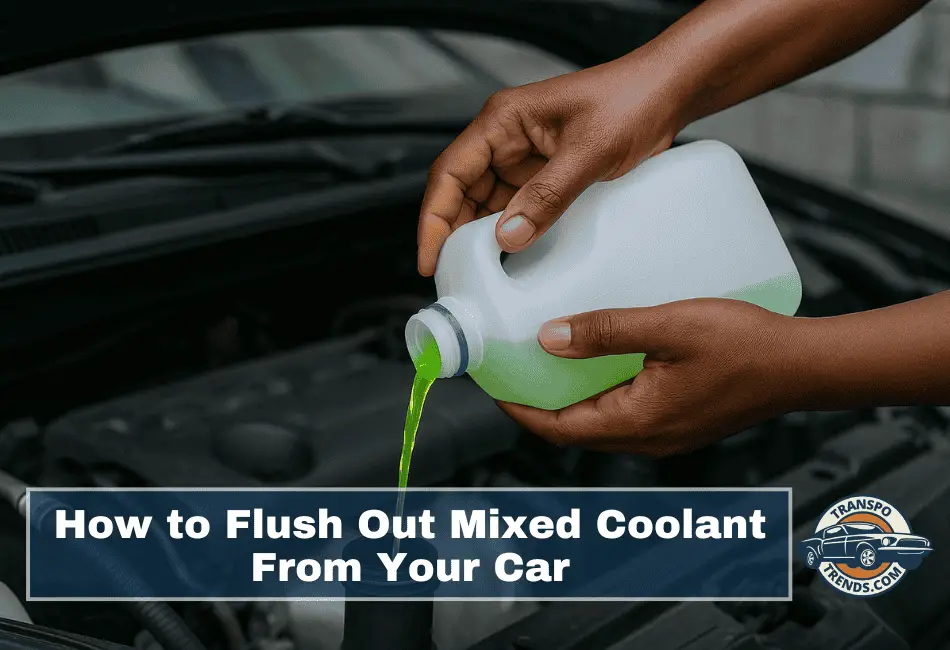The coolant flowing through your engine is not just a colored liquid; it is a vital shield against overheating, corrosion, and catastrophic engine failure.
But what happens when that coolant is not what it should be?
Mixing different coolant types—such as green and pink—can lead to damaging reactions inside your engine. Whether you topped off with the wrong type or inherited the problem from a previous owner, flushing the system is your best course of action.
In this guide, I will walk you through how to safely and thoroughly flush out mixed coolant from your car, helping you protect your investment and restore peace of mind.
Why Mixed Coolants Are a Serious Problem
Coolants are not all the same. While they may look similar in texture, their chemical compositions are vastly different. That is why mixing two incompatible types—like green Inorganic Additive Technology (IAT) and pink or orange Organic Acid Technology (OAT/HOAT)—is a recipe for disaster.
When these formulations combine, they can form a thick sludge that clogs your radiator, restricts coolant flow, and accelerates corrosion. According to Prestone, one of the world’s leading coolant manufacturers, the consequences of mixing coolants can be “catastrophic,” often leading to engine damage, overheating, and failure of key components like the water pump or thermostat.
Common Signs You Have Mixed Coolants
Before diving into the flushing process, look for these warning signs that your vehicle may be suffering from coolant contamination:
- Sludge or gel-like deposits inside the coolant reservoir or radiator
- Murky or brownish coolant, instead of a bright, clear green or pink
- Engine overheating, especially in traffic or while idling
- Coolant leaks from weakened hoses or gaskets
- Check engine light triggered by irregular coolant temperature readings
- Rough engine performance or poor acceleration due to unstable temperatures
If any of these symptoms sound familiar, flushing your coolant system should be a top priority.
Tools and Materials You Will Need
You do not need a mechanic’s garage to do this, but preparation is everything. Here is what you will need:
Basic Tools:
- A large drain pan (minimum 2 gallons)
- Several gallons of distilled water
- A funnel (preferably with a flexible neck)
- New coolant, matched exactly to your car’s specifications
- Optional: Cooling system flush solution, such as Prestone’s Radiator Flush
- Safety gear: gloves, goggles, and protective clothing
Safety First:
- Work on a cold engine—wait at least 1 hour after driving
- Keep pets and children away—coolant is highly toxic
- Dispose of old coolant responsibly at a recycling center or auto parts store
Step 1: Drain the Contaminated Coolant
- Park your car on a flat surface, engage the parking brake, and open the hood.
- Locate the radiator drain valve or loosen the lower radiator hose.
- Place the drain pan underneath and open the radiator cap.
- Allow all the coolant to drain completely. This may take a few minutes.
- Dispose of the old coolant safely in a sealed container.
If you see any signs of sludge or odd discoloration, you have confirmation that a chemical reaction has occurred due to incompatible coolant.
Step 2: Flush with Distilled Water
Distilled water helps clean out the remaining coolant without introducing new contaminants.
- Close the drain valve or reattach the hose.
- Fill the radiator and reservoir with distilled water until full.
- Start the engine, turn the heater on full blast, and let it idle for 10–15 minutes.
- Watch your temperature gauge to make sure the engine does not overheat.
- Turn off the engine, let it cool fully (about 1–2 hours), and then drain the water.
- Repeat this process two or three times, until the water runs clear.
This step helps remove most of the chemical residue and particles left behind by the old coolant.
Step 3 (Optional): Use a Coolant Flush Solution
If your system shows signs of severe contamination or sludge, consider using a chemical flush.
- Follow the product’s instructions exactly—usually adding the flush to the radiator, topping off with water, and running the engine for 45–60 minutes.
- Allow the system to cool.
- Drain and rinse thoroughly with distilled water at least twice to remove all traces of the cleaner.
This adds extra peace of mind when dealing with stubborn deposits or after a long period of improper maintenance.
Step 4: Refill with the Correct Coolant
With a clean system, it is time to refill it properly:
- Consult your owner’s manual for the correct coolant type and quantity. Use only the recommended IAT, OAT, or HOAT coolant.
- Mix 50/50 with distilled water if using concentrated coolant, or use pre-mixed coolant directly.
- Fill the radiator and the overflow tank to the appropriate “cold” line.
- Start the engine again with the heater on high.
- Let it run for 15–20 minutes, then shut off and check the coolant level.
- Top off as necessary.
Step 5: Bleed Air from the System
Trapped air can create hot spots and reduce coolant flow.
- Check your manual to see if your vehicle has a bleeder valve.
- If it does, open the valve while the engine runs (carefully), and close it once coolant flows steadily with no bubbles.
- If not, simply run the engine with the radiator cap off until air bubbles stop appearing, then secure the cap.
Step 6: Monitor and Maintain
Over the next week:
- Check the coolant level every morning.
- Look for leaks under the car.
- Keep an eye on the temperature gauge.
If levels drop noticeably or overheating returns, consult a mechanic. It may indicate a leak or residual air in the system.
Step 7: Dispose of Used Coolant Properly
Never pour coolant into a storm drain, toilet, or on the ground.
- Store it in a sealed container labeled “used antifreeze.”
- Take it to your local AutoZone, NAPA Auto Parts, or municipal hazardous waste center.
- Do not mix used coolant with other automotive fluids during disposal.
Prevent Coolant Mixing Mistakes in the Future
Prevention is always more cost-effective than repair. Here is how to avoid this problem going forward:
- Label your coolant jugs at home clearly.
- Read the fine print—do not rely on color alone. Color is not a reliable indicator of compatibility.
- Buy pre-mixed coolant to avoid errors in dilution.
- Use universal coolant (like Prestone All Vehicles) only if you confirm it meets the OEM standards for your car.
See: Prestone All Vehicles Coolant - When in doubt, flush and replace, especially with newly purchased used vehicles.
Summary: Contaminated vs. Clean Cooling System
| Component | Mixed Coolants (Contaminated) | Flushed and Refilled (Clean) |
|---|---|---|
| Radiator | Sludge build-up, restricted flow | Clear flow, efficient temperature control |
| Hoses | Corroded, brittle, leaking | Flexible, intact, leak-free |
| Coolant Appearance | Brown, cloudy, or gelatinous | Bright, translucent green or pink |
| Engine Behavior | Overheating, sluggish performance | Stable, reliable, and efficient operation |
Why This Matters
Your engine’s cooling system is a silent protector. When treated right, it keeps your car healthy and efficient for hundreds of thousands of miles.
But when coolants are mixed carelessly, damage sneaks in quietly—until it becomes too expensive to ignore.
By learning how to flush your cooling system and recognizing the signs of trouble, you take control of your car’s longevity.
You become more than just a car owner. You become a caretaker of something mechanical, powerful, and trusted.

